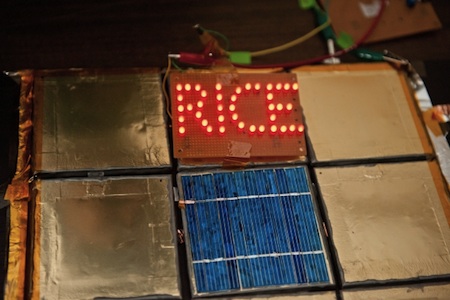Science Fiction
Dictionary
A B C D E F G H I J K L M N O P Q R S T U V W X Y Z
Spray-On Lithium Ion Battery

Rice University grad students have designed a battery that can be sprayed onto a surface.

(Silver-colored panels contain the spray-on batteries covered by a sealant)
The paint contains layers, each representing a necessary component of a conventional battery -- current collectors made in part from purified single-wall carbon nanotubes, a cathode, an anode, and a polymer separator -- as described in a report published today in Nature authored by Rice graduate student Neelam Singh and her team. Spraying the painted battery is a multilayer process, but when you're done, you have a covered surface that stores energy and discharges it when needed -- that is, a battery.
This technology would be perfect for Philip K. Dick's battery-powered comic books from his 1965 novel The Zap Gun, which refers to a battery within the back cover of a magazine.
I can't resist pointing out that this would be a perfect way to store the power from Larry Niven's sprayable solar power cells - black power - from his 1995 story The Woman in Del Rey Crater.
Via Cnet; thanks to Joe for the tip.
Scroll down for more stories in the same category. (Story submitted 6/28/2012)
Follow this kind of news @Technovelgy.| Email | RSS | Blog It | Stumble | del.icio.us | Digg | Reddit |
Would
you like to contribute a story tip?
It's easy:
Get the URL of the story, and the related sf author, and add
it here.
Comment/Join discussion ( 0 )
Related News Stories - (" Engineering ")
Secret Kill Switch Found In Yutong Buses
'The car faltered as the external command came to brake...' - Keith Laumer, 1965.
The Desert Ship Sailed In Imagination
'Across the ancient sea floor a dozen tall, blue-sailed Martian sand ships floated, like blue smoke.' - Ray Bradbury, 1950.
The Zapata Air Scooter Would Be Great In A Science Fiction Story
'Betty's slapdash style.'
Could Crystal Batteries Generate Power For Centuries?
'Power could be compressed thus into an inch-square cube of what looked like blue-white ice' - Edmond Hamilton, 1940.
Technovelgy (that's tech-novel-gee!) is devoted to the creative science inventions and ideas of sf authors. Look for the Invention Category that interests you, the Glossary, the Invention Timeline, or see what's New.
Science Fiction
Timeline
1600-1899
1900-1939
1940's 1950's
1960's 1970's
1980's 1990's
2000's 2010's
Current News
Bone-Building Drug Evenity Approved
'Compounds devised by the biochemists for the rapid building of bone...'
Secret Kill Switch Found In Yutong Buses
'The car faltered as the external command came to brake...'
Inmotion Electric Unicycle In Combat
'It is about the size and shape of a kitchen stool, gyro-stabilized...'
Grok Scores Best In Psychological Tests
'Try to find out how he ticks...'
PaXini Supersensitive Robot Fingers
'My fingers are not that sensitive...'
Congress Considers Automatic Emergency Braking, One Hundred Years Too Late
'The greatest problem of all was the elimination of the human element of braking together with its inevitable time lag.'
The Desert Ship Sailed In Imagination
'Across the ancient sea floor a dozen tall, blue-sailed Martian sand ships floated, like blue smoke.'
The Zapata Air Scooter Would Be Great In A Science Fiction Story
'Betty's slapdash style.'
Thermostabilized Wet Meat Product (NASA Prototype)
There are no orbiting Michelin stars. Yet.
Could Crystal Batteries Generate Power For Centuries?
'Power could be compressed thus into an inch-square cube of what looked like blue-white ice'
India Ponders Always-On Smartphone Location Tracking
'It is necessary... for your own protection.'
Amazon Will Send You Heinlein's Knockdown Cabin
'It's so light that you can set it up in five minutes by yourself...'
Is It Time To Forbid Human Driving?
'Heavy penalties... were to be applied to any one found driving manually-controlled machines.'
Replace The Smartphone With A Connected Edge Node For AI Inference
'Buy a Little Dingbat... electropen, wrist watch, pocketphone, pocket radio, billfold ... all in one.'
Artificial Skin For Robots Is Coming Right Along
'... an elastic, tinted material that had all the feel and appearance of human flesh and epidermis.'
Robot Guard Dog On Duty
I might also be thinking of K-9 from Doctor Who.
